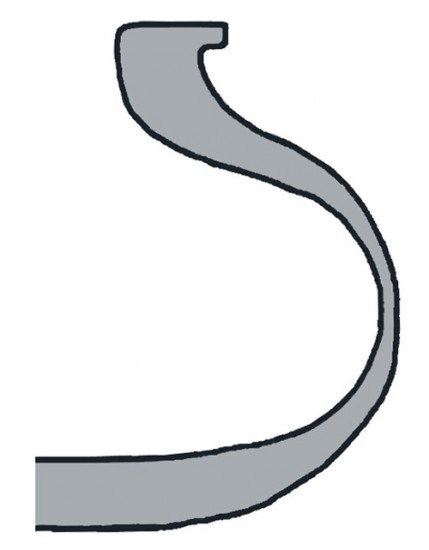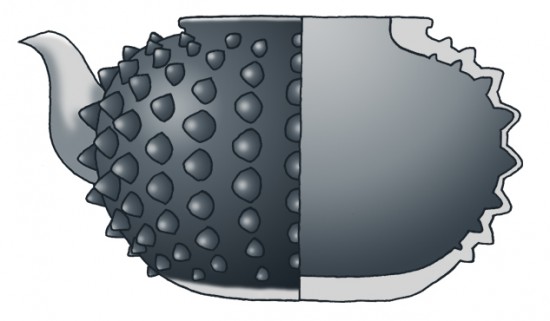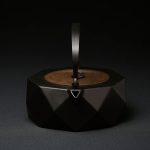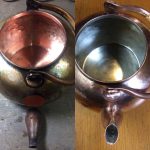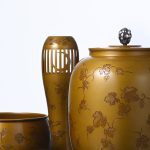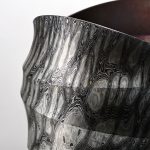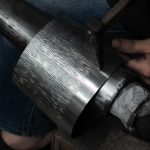Let us talk about the traditional Japanese metalworking method in relation to the Ginbin, silver kettle. The silver kettle has been used in the tea ceremony for a long time. As with other utensils used for the tea ceremony, the silver kettle was seen as a status symbol, and as precious metal was used to make this tool, it was produced as a luxury item. These days, you can find various silver kettles brought about by increasing demand in a high-growth economy and the development of the processing technique.
■Cross-section view of a kettle (hammering)
Originally the refined shape of the silver kettle was related to the fact that it was made without any waste because such expensive metals were used. The above picture shows the cross-section of such a kettle. It is made from one lump of metal and beaten with a hammer to shape it.
Particularly noteworthy is the differing thickness of the walls of the silver kettle. It is shaped to create its beauty, to have a solid feel and with a good balance when used. It is quite thick at the bottom where it sits on the grill (or grate of the fire). We may say that this is the perfect shape for a pot which is used on a flame.
■Cross-section view of a kettle (spinning)
This is the cheap industrial version. It is called Herashibori, spinning which is molded at high speed. It is exceptionally light and has the same thickness throughout.
■ Cross-section view of upper part of a kettle (hammering)
The picture above shows the cross-section of the kettle where the lid sits. What you should look for most is the solid appearance when viewed from the top with the lid removed. With the most skillful hammer work, a greater thickness is achieved in this top part. This traditional method is called Ikehata. You can tell it is a high-quality silver pot because when you trace the inside with the lid off with your finger it feels exceptionally smooth.
■Cross-section view of upper part of a kettle (spinning)
The picture above shows a cheap version which is produced with a machine. It looks like it has been made with Ikehata, but it only mimics the shape. If you run your finger along the inside, you will notice a distinct protrusion, which is the sign of its cheap quality.
■Arare pattern (hammering)
There are many kinds of silver kettle but the most popular one is called Arare which has a protruded cone pattern. Within Arare, there are cheap and high-quality variations. This is how you can notice a high-quality Arare.
A traditional high-quality Arare has a beautiful cone shape with a sharp point. Just to make one cone, you must use a special tool many times to make the shape. Because the protrusion is sharp, Arare which is covered all over looks elegant and beautiful. The protrusion becoming bigger towards the center is worth noticing.
■Arare pattern (spinning)
The cheap version has a protrusion which is not sharp. To make the protrusion produced by machine, the shape has to be low and not sharp which may easily break. However, this does not make a beautiful pattern. Also, there is not much variation of size and shape of the cones between the center and the top and bottom of the kettle.
You can find various kinds of silver kettle but if you are aware of these points, you will not make the mistake of buying a cheap one at a high price. Please think about these points when looking to buy an Arare pattern silver pattern kettle.



